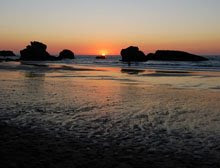Went to the Royal Society on Monday evening to listen to a public lecture. The title was Climate Change on Living Earth by Professor James Lovelock. I remember hearing about James Lovelock in the Sustainability lectures and about he created the Gaia concept. He also created the theory of thinking about Earth as living system and how this should be the way you see earth to research and respond to climate change.
He started the lecture about talking about he has an apocalyptic view of the future and how we are already running out of time to respond to the increasing problem of climate change. We are not acting fast enough at the moment. He also said that implementing the Kyoto protocol is not going to be enough. I guess these are things we might have already known or started to realise. He went on to say that the most important thing at the moment is to find ways to extend the time we have to act to climate change. This could be by finding technological solutions to help slowing up climate change.
He spoke of the division in the scientific field and how this has a negative effect on research. He discussed the IPPC report which has just come out and called it conservative. He doesn't think it has a realistic view on climate change and that the targets are not enough.
The next thing which can up was the concept of global dimming and how this actually cools the earth and the fact that if reduction of CO2 in the atmosphere goes too fast this might raise the temperature of the earth instead. If this is done to quickly the temperature might increase by that crucial 2 - 3 degrees which would wipe out big parts of wildlife and ecosystems. James Lovelock said: 'We are damned if we keep burning fossil fuels and damned if we stop too fast'.
Other things mentioned were the fact that most climate change models only account for atmospheric changes and not on the living earth system and the fact that even if the level of CO2 goes down, it might already be too late.
So, what is James Lovelock's solution to this? He talked about what has already been mentioned the importance of thinking of earth as a living system. About stimulating the earth to cure itself and restoring the balance in nature. About reducing emissions and protecting natural forest (instead of planting new).
But the real thing that he said was the world needs a climate catastrophe to wake up. (I thought that there already have been a lot of them over the past years.) He mentioned climate refugees and mass migration and that the northern countries need to start to prepare for this and said that a similar response as in wartime is needed. Human rights require human obligations.
I learned a few new things in the lecture, but what mostly surprised me was how kind of negative James Lovelock's view of the future and the climate change is. It was good to hear in a way, cause it does seem realistic at this point, changes are not coming fast enough, even though climate change will affect all of us in our daily lives. You need to be prepared for big changes and be prepared to commit to them . Starting with increasing with what you might already be doing. And it is a fact that no one really knows what the effects of climate change will have on our lives, but I think everyone will admit that it is happening and you can't ignore research, even though it might be a lot more negative and scary even than you would like. So, I agree we need to wake up. Not just Europe but the whole world. Climate changes is a global issue.




 They say that Jean Prouve was the man who invented high-tech. He worked in architecture, but wasn't an architect. He was a designer and an engineer. He designed unique furniture and moved on to buildings. Some of the models on show are amazing. Some are surprisingly organic and ecological and feel very contemporary at the same time
They say that Jean Prouve was the man who invented high-tech. He worked in architecture, but wasn't an architect. He was a designer and an engineer. He designed unique furniture and moved on to buildings. Some of the models on show are amazing. Some are surprisingly organic and ecological and feel very contemporary at the same time This model is of a youth center proposal for Ermot done in 1967.
This model is of a youth center proposal for Ermot done in 1967.







 Close up of one of the nests, with seating platforms with movable columns so you create your own nest.
Close up of one of the nests, with seating platforms with movable columns so you create your own nest.  Sketch showing the bit underneath the overhang, where a bit is cut out to just let the water overflow onto the site. A more protected nest.
Sketch showing the bit underneath the overhang, where a bit is cut out to just let the water overflow onto the site. A more protected nest. The red circles marking out the nesting sites and the red lines explaining the angles of the lines of columns.
The red circles marking out the nesting sites and the red lines explaining the angles of the lines of columns. Sketch showing how the seating platforms sit on the different levels.
Sketch showing how the seating platforms sit on the different levels.









